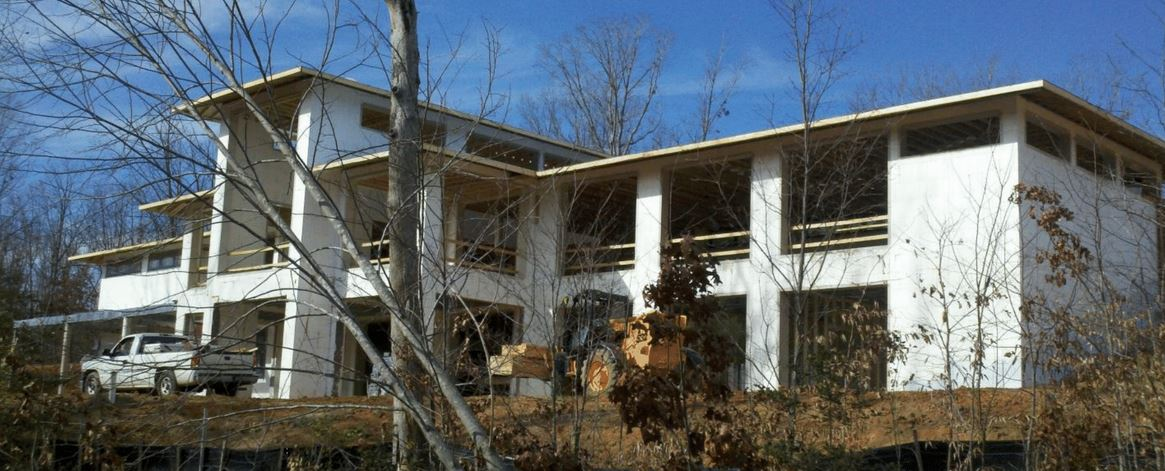
7 Problems with Wood Frame Construction

Fox Block ICF wall assembly avoids many of the problems associated with wood frame construction. Unlike wood frame walls, Fox Block walls are fire- and wind-resistant, durable, low thermal mass, not susceptible to shrinkage, and provide excellent indoor air quality (IAQ) and sound control.
While wood frame construction is a common building method, several problems continue to challenge contractors and building owners. Seven specific problems with wood frame construction include fire- and wind-resistance, durability, low thermal mass, shrinkage, and compromised acoustics and indoor air quality (IAQ).
Seven Problems with Wood Frame Construction

1. Fire Resistant Problems with Wood Frame Construction
Building a fire-resistant wood frame building requires contractors to limit the spread of fire by cladding the wood frame in materials that resist heat and treating the wood with fire retardants. Unfortunately, this leaves wood-frame buildings in the early stages of construction especially susceptible to fire damage, before completing placement of fire protection over the wood frame.
2. Wind Resistant Problems with Wood Frame Construction
Constructing and designing of a severe-wind-resistant wood frame building is labor and cost intensive. A wind-resistant wood frame structure must include a continuous load path to the ground and missile resistance. A study by the Housing and Building National Research Center found that building a wind-resistant wood-framed structure can cost 25–30 percent more than standard construction.
3. Durability Problems with Wood Frame Construction
Building a wood frame structure that is durable is challenging because wood is susceptible to termite problems and moisture. Termites damage a structures durability. Moisture can lead to wood rot, which will degrade the integrity of a wood frame building. Both termites and moisture exposure to wood frame buildings can cost thousands of dollars in maintenance and repair.
4. Low Thermal Mass Problems with Wood Frame Construction

The low thermal mass of wood creates buildings that are not as naturally energy-efficient as high thermal mass products like stone and adobe. High thermal mass wall products pull in and store heat energy in the day and release the energy during the cooler evenings. The process reduces the rate of heat transfer and helps to stabilize temperature shifts within a structure.
5. Shrinkage Problems with Wood Frame Multi-Story Construction
Designing and constructing a multi-story wood frame building are problematic because wood naturally shrinks when it dries. Wood frame structures can shrink up to one-fourth inch or more per floor, depending on environmental factors and the type of framing. So, a five or six story wood frame building can shrink up to more than 1.25-inch. In addition, the structure may settle when fully loaded.
6. Problems with Creating Healthy Wood Framed Buildings
Building a healthy wood frame structure is problematic because they are susceptible to moisture in the wall systems. Moisture can cause mold, which may cause allergic and asthmatic reactions in some people. Wood-frame buildings may also contain chemicals, adhesives, and volatile organic compounds (VOC). Both mold and VOCs compromise the IAQ of a building.
7. Sound Insulation Problems with Wood Frame Construction
It is challenging to construct a wood-framed building with sufficient sound insulation. Builders of wood frame structures must include time-consuming and costly methods to achieve sound reductions. Techniques for lessening sound within a wood frame building include applying a heavy board like fermacell gypsum fibreboard panels or doubling up on the plasterboard.
Solve Problems of Wood Frame Construction with Fox Block ICF

The Fox Block insulated concrete forms (ICFs) solve many of the problems associated with wood frame construction. The Fox Block system is fire- and wind-resistant, durable, low thermal mass, and provides excellent indoor air quality and sound control. Fox Blocks are also not prone to shrinkage, like wood, so a much better choice over wood construction, particularly for multi-story structures.
Fox Blocks are More Fire Resistant than Wood Frame Construction
Fox Blocks achieve a fire-resistance rating (ASTM E119) of four hours for the six-inch and 8-inch Blocks and two hours for the four-inch Blocks.
Fox Blocks are More Wind-Resistant than Wood Frame Construction
Fox Blocks, with steel reinforced concrete, are sever-wind-resistant and can withstand winds of over 200 MPH, and projectile debris traveling over 100 MPH.
Fox Blocks are More Durable than Wood Frame Construction
Fox Blocks lack organic material, which termites eat, so are more durable than wood.
Furthermore, Fox Blocks are durable because they create a solid continuous monolithic concrete wall system with a perm rating of 1.0, which controls moisture infiltration and prohibits the growth of mold, which will degrade the integrity of a building.
Fox Block have Greater Thermal Mass than Wood Frame Construction
The high thermal mass of Fox Blocks creates a high-performing, energy-efficient building.
Fox Blocks Provide Superb Indoor Air Quality
Fox Blocks, with a perm rating of less than 1.0, control moisture intrusion which stops the growth of unhealthy mold. In addition, Fox Blocks contain little to no VOC.
Fox Block Provide Excellent Sound Control
Sound transmission tests found that no more than a third of sound passes through ICF walls; providing better noise and sound insulation than lightweight timber. Fox Blocks have a Sound Transmission Classification (ASTM E90) of 4-inch=STC 46, 6- and 8-inch = STC 50+.

An ideal product that avoids the problems of wood frame construction is the Fox Block ICF wall assembly. Fox Blocks are fire- and wind-resistant, durable, low thermal mass, and provide excellent indoor air quality and sound control. Moreover, Fox Blocks do not shrink and are also easy to install.